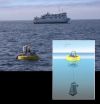New remote control for molecular motors
It is now theoretically possible to remotely control the direction in which magnetic molecules spin, which opens the door to designing applications based on molecular motors
2015-03-16
(Press-News.org) In the eyes of physicists, magnetic molecules can be considered as nanoscale magnets. Remotely controlling the direction in which they rotate, like spinning tops, may intuitively be difficult to achieve. However, Russian physicists have just demonstrated that it is theoretically possible to do so. They have shown that a change of direction in the circular polarisation of an external magnetic field leads to a change in the direction of the mechanical rotation of the molecule. These findings by Iosif Davidovich Tokman and Vera Il'inichna Pozdnyakova from the Institute for Physics of Microstructures, Russian Academy of Sciences, Nizhny Novgorod, Russia, were recently published in EPJ B. Possible applications of the phenomenon include rotating magnetic molecules used as molecular rotors to power molecular motors.
The authors were inspired by recent experimental observations, in which molecules that are not magnetic can freely rotate around a fixed axis on the surface of crystals. Tokman and his colleague had the idea of using magnetic molecule to remotely control their rotation using a circularly polarised magnetic field. The authors then developed a theoretical explanation to this gyromagnetic phenomenon at the nanometric scale, which was already well known at the macroscopic scale. The rotational speed of a molecular magnet around its own axis, they have shown, depends on the polarisation and frequency of an external alternating magnetic field.
To provide a more comprehensive picture of the molecular rotation, they relied on classical equations - used at macroscopic-scale - to explain the motion for spin degrees of freedom, which can be polarised. They then combined them with quantum mechanics - typically used for sub-microscopic-scale entities - to describe the mechanical rotational degrees of freedom and their interaction with the spin polarisation. These findings have yet to be confirmed experimentally.
INFORMATION:
Reference:
I.D. Tokman and V. I. Pozdnyakova (2015), Mechanical rotation of nanomagnets through interaction with an electromagnetic wave, Eur. Phys. J. B 88: 51,
DOI: 10.1140/epjb/e2015-50438-6
ELSE PRESS RELEASES FROM THIS DATE:
2015-03-16
(Boston)--Family support during deployment is an important protective factor against post-deployment suicidal ideation according to a new study in the journal Anxiety, Stress and Coping.
Suicidal ideation includes thoughts that can range from fleeting consideration of suicide to the development of a specific plan for killing oneself. Research on suicidal ideation in veterans who served in support of Operation Enduring Freedom (OEF) in Afghanistan and Operation Iraqi Freedom (OIF) in Iraq has revealed a number of important predictors of suicidal ideation, including potentially ...
2015-03-16
Millennials are anything but "newsless," passive, or uninterested in civic issues, according to a new comprehensive study of the information habits of people age 18-34. The research looks closely at how members of the Millennial generation learn about the world on different devices and platforms.
The study finds that Millennials consume news and information in strikingly different ways than did previous generations. Contrary to popular perception, they keep up with news that is commonly referred to as "traditional" or "hard," as well as stories that connect them to hobbies, ...
2015-03-16
Our modern epidemic of obesity has led to an alarming rise in the incidence of diabetes. More than 382 million people on the planet suffer from diabetes, predominantly type-2 diabetes. For these people, blood sugar surges -- glucose spikes after meals -- can be life threatening, leading to cardiovascular complications.
A new Tel Aviv University study published in Diabetologia proposes a new way to suppress deadly glucose surges throughout the day -- eating a high-caloric breakfast and a more modest dinner. According to TAU's Prof. Daniela Jakubowicz and Dr. Julio Wainstein ...
2015-03-16
March 16, 2015- Special redesigned labels for intravenous (IV) medication bags may help to prevent serious medication errors in the operating room, reports a study in the March issue of the Journal of Patient Safety. The journal is published by Wolters Kluwer.
Based on trainee behaviors during OR simulations, "The results of this study provide additional evidence to support the use of opaque, white medication labels and the use of inverted text for highlighting key medication information on the label," writes Jamie L. Estock, MA, of the VA Pittsburgh Healthcare System ...
2015-03-16
March 16, 2015 - The shooting of an unarmed teenager in Ferguson, MO, has ignited a global discussion about implicit racial bias. One group of people you might think would be immune from this hidden bias is clinical therapists, people trained to understand the human mind. But a new field study finds that the social identities of patients and their therapists affect the accuracy of the diagnosis: Therapists were twice as likely to misdiagnose mental illness when their patients were members of a disadvantaged, compared to an advantaged, group.
In her own practice, Ora Nakash, ...
2015-03-16
There is still no evidence of genetic difference between blacks and whites to account for the health disparities in cardiovascular disease (CVD), according to a new study by McGill University researchers. Published in the American Journal of Epidemiology, the researchers suggest that after a decade of genetic studies, factors such as lifestyle, education and socio-economics - not genetics - are more promising avenues to understanding racial health disparities.
The researchers focused on cardiovascular disease, the largest contributor to the racial mortality gap, and ...
2015-03-16
Colon cancer is a heavily studied disease -- and for good reason. It is one of the leading causes of cancer-related deaths worldwide, and its numbers are on the rise, from 500,00 deaths in 1990 to 700,000 in 2010.
This growth comes despite scientists' ever-increasing knowledge of the genetic mutations that initiate and drive this disease. Now, a team of researchers from the University of Pennsylvania has found evidence of a new culprit in the disease, a protein called MSI2.
Their findings provide a new target for potential therapeutic intervention in colorectal cancer ...
2015-03-16
A research group in the UA Lunar and Planetary Laboratory has found evidence in meteorites that hint at the discovery of a previously unknown region within the swirling disk of dust and gas known as the protoplanetary disk - which gave rise to the planets in our solar system.
Led by Kelly Miller, a doctoral student in the lab of Dante Lauretta, the principal investigator of NASA's OSIRIS-REx mission, the team has found evidence of minerals within meteorites that formed in an environment that was enhanced in oxygen and sulfur and date from a time before the particles stuck ...
2015-03-16
Researchers from the University of Hawai'i - M?noa (UHM) and colleagues found that microbial communities in different regions of the Pacific Ocean displayed strikingly similar daily rhythms in their metabolism despite inhabiting extremely different habitats - the nutrient-rich waters off California and the nutrient-poor waters north of Hawai'i. Furthermore, in each location, the dominant photoautotrophs - light-loving bacteria that need solar energy to help them photosynthesize food from inorganic substances - appear to initiate a cascade effect wherein the other major ...
2015-03-16
The studies below will be presented at the American College of Cardiology's 64th Annual Scientific Session on Sunday, March 15.
1. Survey Suggests Cardiologists May Not Be Prepared to Counsel Patients on Heart Healthy Diets
Even though most doctors believe diet is important in preventing and managing cardiovascular disease, there are major gaps in their knowledge and, in turn, efforts to educate patients about heart healthy diets may be falling short, according to a recent survey of 236 cardiologists and internal medicine physicians and trainees at a large tertiary ...
LAST 30 PRESS RELEASES:
[Press-News.org] New remote control for molecular motors
It is now theoretically possible to remotely control the direction in which magnetic molecules spin, which opens the door to designing applications based on molecular motors


